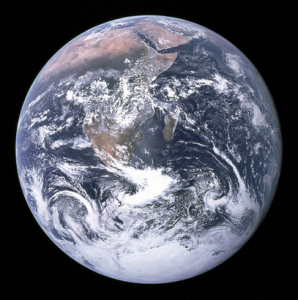
“The Earth seen from Apollo 17” by NASA/Apollo 17 crew; taken by either Harrison Schmitt or Ron Evans – http://www.nasa.gov/images/content/115334main_image_feature_329_ys_full.jpgAlt: http://grin.hq.nasa.gov/ABSTRACTS/GPN-2000-001138.html (direct link). Licensed under Public Domain via Commons – https://commons.wikimedia.org/wiki/File:The_Earth_seen_from_Apollo_17.jpg#/media/File:The_Earth_seen_from_Apollo_17.jpg
“There is no separate self,” say the Buddhists. Twenty-five years ago I couldn’t warm up to the idea. Of course selves are separate; that’s why I was putting so much individual work into building one. Separate self? It was repetitious, a tautology.
But twenty-five years of getting my awareness raised about ecological crises is drumming into me the truth of the Buddhist axiom. When it comes to an ecosystem—like this planet—there is indeed no separate self. Every action of every individual affects all others. No one an island, as Donne said. Acting in isolation is impossible.
These days it is not poets and religious folks who are preaching the message loudest. It is scientists and environmental journalists. From the IPCC 2007 Report on Climate Change, which shows beyond a reasonable doubt that the actions of industrialized societies are endangering the Earth for all, to data on water pollution downstream from power plants, to the study that just came out last week that pollution in alpine lakes far from direct human contact is measurably worse than previously thought, we have hard evidence of the connections that for most of the 2500 years of Buddhist history had to be taken on faith.
Each of us is intimately connected to every fish and bird and blade of grass and human being and every inch of soil on the rest of the planet. And not in some airy-fairy kind of way. We’re connected physically—breathing the same air, sharing the same water, tied by strands of biology and chemistry and physics, and tied most of all by our shared need to eat, to every other organism on this single planet Earth.
Or, better, we ARE a single organism called Earth.
A few days ago, when I posted on the pollution in Rocky Mountain lakes, a reader expressed his overwhelm, which I share. What can we do? he asked—a question thousands of us are asking.
I think one thing to do is use the ecological crisis as a blunt communiqué of connection—an in-your-face reminder that we depend on the trout and the algae and the warblers and the wheat grains for our very survival. That if we wreck the living conditions on the Earth for them, we are wrecking it for ourselves.
There is no simpler way to express the lack of separation: if they go, we go.
(Though the reverse is not true; the more-than-human world existed just fine for millennia before we appeared.)
And here’s where the spiritual practice comes in. Most of us forget just how unseparate everybody here is. We need to practice reminding ourselves, at the feeling level, of our connection to and dependence on every other being on Earth.
Spirituality is often defined as finding our connection to something greater than ourselves. The “something greater” we have most lost touch with is the web of connections linking all of us here on the only livable planet we will ever know.
I suggest that we contemplate our dependence on fungi; that we meditate on the miracle of photosynthesis, of green plants taking carbon dioxide and turning it into oxygen; that we connect with a tree—or with any other neighbor, human or otherwise; and most of all that we strive to understand how our own actions and our everyday choices are contributing to balance or imbalance in a cycle of life that is much more delicate than we used to think.
Buddhists may contemplate the web of interdependence linking us all. Christians can ponder Jesus’s words that how we treat “the least of these”—the sick, the poor, the thirsty—is how we are treating him. And anybody can sit with a friend, whether flower or feline or human, and appreciate the intricacy of that friend’s face.
And once we have sat and observed and contemplated, we can take our insights to the farmers’ markets and the grocery stores, to our dinner table and our utility company. We can tell our elected leaders that we can no longer afford pesticides in breast milk and nitrogen in alpine lakes; that we will commit ourselves to decreasing fossil fuel use; and that lowering CO2 in the atmosphere, if it is a matter of life and death for farmers in India and Africa, is a matter of life and death for the rest of us as well.
Twenty-five years ago, the idea that there is no separate self could seem counterfactual, an illusion. Today we have the data that proves, to our amazement and often to our sorrow, just how urgently true it is.
Today the idea of separateness is the illusion—one that we, the Earth, can no longer afford.